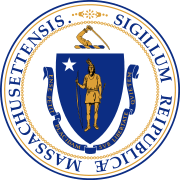John Reed Jr.
| John Reed, Jr. | |
|---|---|
| Member of the U.S. House of Representatives from Massachusetts's 11th district | |
|
In office March 4, 1833 – March 3, 1841 | |
| Preceded by | John Quincy Adams |
| Succeeded by | Barker Burnell |
| Member of the U.S. House of Representatives from Massachusetts's 13th district | |
|
In office March 4, 1823 – March 3, 1833 | |
| Preceded by | William Eustis |
| Succeeded by | District eliminated until 1893 |
| Member of the U.S. House of Representatives from Massachusetts's 9th district | |
|
In office March 4, 1815 – March 3, 1817 | |
| Preceded by | Laban Wheaton |
| Succeeded by | Walter Folger Jr. |
|
In office March 4, 1821 – March 3, 1823 | |
| Preceded by | Walter Folger Jr. |
| Succeeded by | Henry W. Dwight |
| Member of the U.S. House of Representatives from Massachusetts's 8th district | |
|
In office March 4, 1813 – March 3, 1815 | |
| Preceded by | Isaiah L. Green |
| Succeeded by | William Baylies |
| 17th Lieutenant Governor of Massachusetts | |
|
In office January 9, 1844 – January 11, 1851 | |
| Governor | George N. Briggs |
| Preceded by | Henry H. Childs |
| Succeeded by | Henry W. Cushman |
| Personal details | |
| Born |
September 2, 1781 West Bridgewater, Massachusetts |
| Died |
November 25, 1860 (aged 79) West Bridgewater, Massachusetts |
| Political party |
Federalist National Republican Anti-Masonic Whig |
| Alma mater | Brown University |
| Occupation | Lawyer |
John Reed Jr. (September 2, 1781 – November 25, 1860) was a Representative from Massachusetts.
Reed was born in West Bridgewater, Massachusetts. He graduated from Brown University, Providence, Rhode Island in 1803, and was a tutor of languages in that institution for two years, and principal of the Bridgewater, Massachusetts Academy in 1806 and 1807. He studied law, was admitted to the bar, and commenced practice in Yarmouth, Massachusetts.
Reed was elected a member of the American Antiquarian Society in 1814, [1] and a Fellow of the American Academy of Arts and Sciences in 1830.[2]
He was elected as a Federalist to the Thirteenth and Fourteenth Congresses (March 4, 1813 – March 3, 1817); elected to the Seventeenth through Twenty-third Congresses; elected as an Anti-Masonic candidate to the Twenty-fourth Congress, and elected as a Whig to the Twenty-fifth and Twenty-sixth Congresses (March 4, 1821 – March 3, 1841). He was chairman of the Committee on Revisal and Unfinished Business (Twenty-second Congress). He declined to be candidate for reelection in 1840.
He was the 17th Lieutenant Governor of Massachusetts (1845–1851).
Reed died in West Bridgewater, Plymouth County, Massachusetts. Interment was in Mount Prospect Cemetery, Bridgewater, Massachusetts.
Reed was the son of John Reed Sr.
References
- ↑ American Antiquarian Society Members Directory
- ↑ "Book of Members, 1780–2010: Chapter R" (PDF). American Academy of Arts and Sciences. Retrieved September 9, 2016.
- United States Congress. "John Reed Jr. (id: R000121)". Biographical Directory of the United States Congress.


